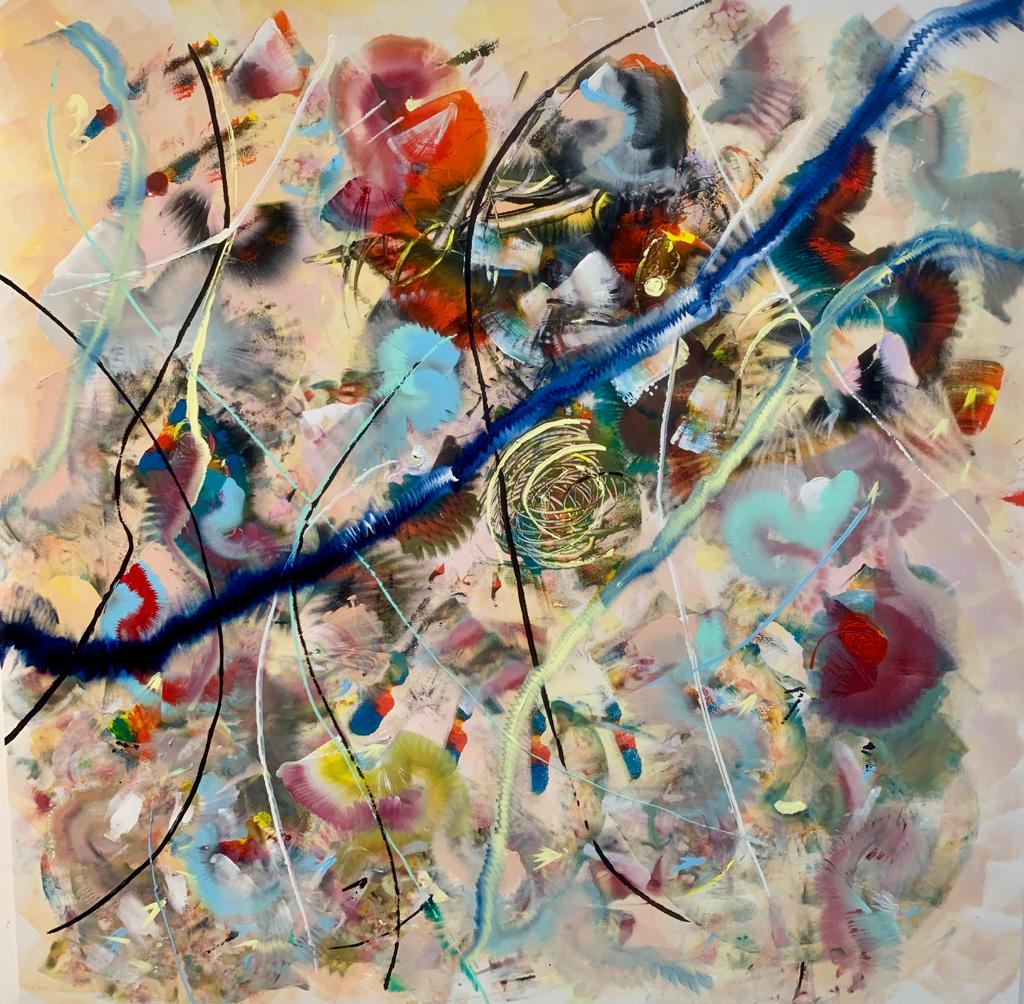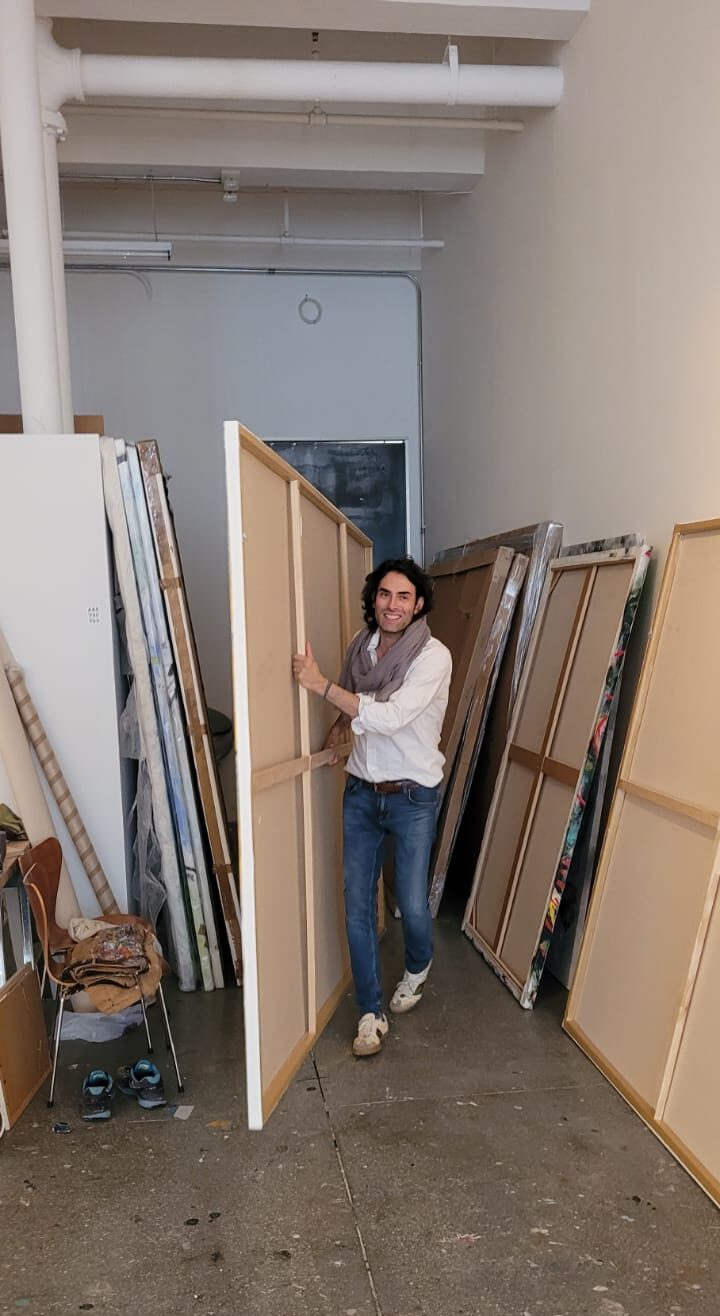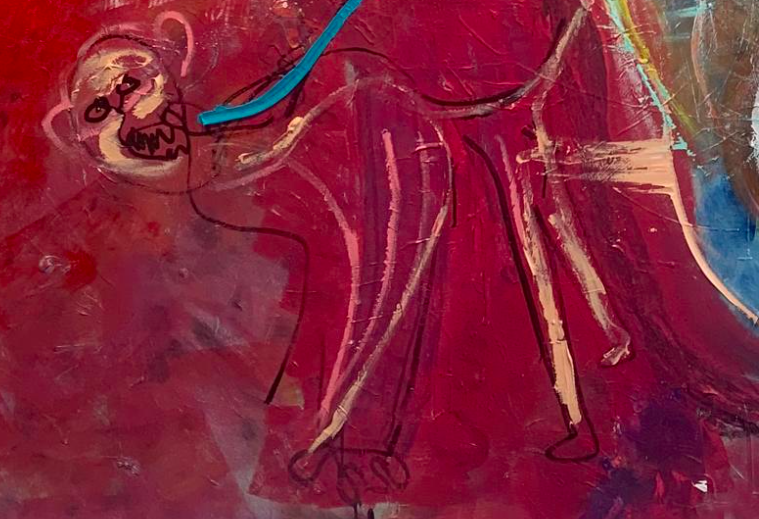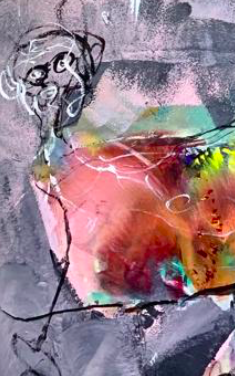Conversations with a Canvas
“These colors, they decimate. That’s why we do what we do!”
Please pull up a seat and let me transport you across a canvas. Let’s follow a whirling dervish of intensity dance within the shadows, bask in frothy shades, leap in the light, and feel a spirited display of color on full tilt created on a canvas by Alexander Yulish. Experience how he can create a lyrical whimsy that beckons conversation!
There is a curious toggling of discovery and reflection within splashes of colors and patterns that reveal both the artist and his painted, enchanted world.
There are stony stares and an eye you can’t catch
Embellished boots and jackets that match
Swaying bodies ablaze with color and
Proximal doors leading into each other
Ducking from the world or are they just bored?
Expecting someone or being ignored?
More than mere figures, they have their own tribe
Bothersome, or buddies it’s hard to describe
Linger if you want; they don’t mind you are there
You’ll most likely spot them when you look everywhere
They Frolick around as stillness on display
and I don’t think he’d have it any other way

Alexander Yulish “Untitled”: Acrylic and Collage on Canvas Photo by: Keith Greenbaum, Keith Greenbaum Studio
Shape Shifter
First and foremost, I love how there is no certainty about time or place in his paintings. And the colors!
Big blues, taffeta pinks, oranges (a new color for him in his works this year), and texturing brings a feeling of deep exhalation and heightened sensitivity imparted freely and intuitively in and around the paintings. At times, silkscreen will be wrinkled or not fully attached, giving a voyeuristic eye a temptation to peek at what is below it and see what is being covered in the shade. Yulish can shift shapes and collage into intricate color alliances, unveil biomorphic figures with a rich and unique balance of sway and strife over the canvas, creating a lyrical whimsy that beckons conversation!
We are all fans, but it’s not a fan brush
DP- There are these strokes in your work. Is it a fan brush?
AY- No, it’s a technique I have; the way I move the brush, it’s a mood, and it’s intense. There’s a release while it’s happening that I can’t explain, but I enjoy it!
Yulish will Invade harmony with an instinctive sassiness, like placing a cerulean fanned out slash on the bias across the entire canvas, happily bringing Tobasco to his tea party to spice things up. (Add that to your finger sandwich!) When you know him, you know when he does this; it just felt right to him. It began where it began, and it ended where it did, and if it was directly over the whole composition, so be it!

Alexander Yulish “Unititled” Acrylic on Canvas, Photo: Courtesy of the artist
One can almost overhear his thoughts and sense his pleasure as he ruffles feathers because he understands it’s often the scratch on a vinyl record that makes you listen more intently, heightening the experience.
Ready for a closeup?
Alexander Yulish has an energy you want to bottle. He is a sensitive, effervescent good finder with a wicked sense of merriment, creating works that pulse with color and sing with magical spectacle, captivating the viewer with equal parts charisma, relatability, and surprise.
Growing up in New York City, he shared time between living with his father, who worked in PR, and his mother, a well-esteemed artist, illustrator, and sculptor, Barbara Pearlman. He was immersed in an art-centric environment, watching his mother paint for hours in her studio. His parents provided and encouraged a creative setting for him to develop his artistic path by example. He accredits his mother for being the one to foster his technique and teach him to be true to his process.

Alexander Yulish in front of a stunning work: 84″ x 168″ acrylic on canvas Photo By: Keith Greenbaum, Keith Greenbaum Studio
DP- Do you go to work every day?
AY- When I was upstate for 3.5 months, I would go every day. I have a studio on my property. Right now, my studio is in NJ. I’ll work Mon-Fri- I don’t wait for inspiration to paint, then you sit around waiting forever.
DP- Did you read my article on Chuck Close, when he said, “Inspiration is for Amateurs”?
AY- I love that! Who has the balls to say that in the art world? I have to hear about inspiration all day long. Something always happens when you just do the work. Inspiration is a misconception; people think artists, they get their coffee, they paint a little… No, it’s brutal, man! The more you paint, the more you push. It’s like you’re driving a car, and you want to take that car and burnout the engine. You want a wheel to fall off! That’s what it is like, at least for me. I want to be shaking by the end of it. I want my hand to be exhausted. There is a point, if you get too tired, you get sloppy, and you have to stop.
DP- Tell me about finding yourself in the process.
AY- I was watching a movie, and in it, someone said, “Your narcissism is so mediocre” I thought it was one of the funniest things I’ve ever heard – I don’t even know how I arrived at that, but I try to laugh at myself a lot and find humor in it. I think my artwork is not original. My artwork is the human condition.
DP- How do you even explain that unless you feel it yourself? Of course, it’s unique.
AY- This is a conversation that no one has had before. Isn’t this the first conversation? You enlightened me, and perhaps you changed my mind; that’s a conversation. That’s exciting! Why be stuck in your ways? To me, that’s boring. It’s like saying I eat sushi all the time, and I can’t wait to share it with you. These colors they decimate. That’s why we do what we do!

“There’s a Monkey in the Disco Booth!” Acrylic and collage on Canvas Photo: Courtesy of the artist
Title me this:
What is the name of this painting? I asked one day on the phone while we were looking at some of his paintings.
AY- “You interpret the story the way you want to interpret the story. I am here to give it to you.” was his response. After carefully observing, I laughed and said, ” It looks like there’s there’s a monkey in the Disco booth,” and that’s what it’s called now. He told me that he doesn’t like to title all of his paintings, as he leaves it up to the viewer to interpret it the way they experience it. It’s more fun for him, and this is how this one came to be.
While visiting him in his studio, He thoughtfully had the Monkey in the Disco booth, waiting for me on one of the walls.

Alexander Yulish in his studio Photo by: Donnalynn Patakos
In the Studio
What’s apparent immediately in the studio is his warmth. There are large windows, tall ceilings, and it’s a good thing because a) He is tall and b) He prefers to paint large-scale. He carries around his canvases effortlessly, hanging them up with a big smile, completely engrossing us with his explanations of the works.
DP- How big do you go?
AY- The Largest was 20′ x 18′. I’ve done a 7′ x 13′. I like to do 6.5′ x 6.5′ or 8′ x 10′. I like 4.5′ x 4.5′. The smaller ones are even more complex!
DP- Do you feel confined when you go to a smaller size?
AY- I do! It’s compressed, just getting it in that conversation and saying, you know what? You will have to say everything in 20 words, not 1000 words, and it better be just as clear and just as precise. It’s really difficult at times, but I’m so relieved when I feel like there is work that works! Sometimes, you throw them out and never want anyone to see them, and sometimes you leave it, and others you go back to a month later, and you think, what the hell was I thinking? And there are some you just love, and you don’t want to paint over.
DP- Have you ever done work, put it on the side because you weren’t feeling it, go back later, and think, this is amazing! What was I thinking?
AY- Yes, I have felt that! It’s so funny when you say to yourself, “Oh, it’s amazing, it’s so good, this is a home run”, and someone just walks by and doesn’t even look at it for two seconds, it doesn’t even resonate with them.
I remember being at one of my shows. I looked over and saw someone and it It looked like they literally got punched in the stomach, when they were looking at a painting. I was like, “Oh God!” and I was so happy they really emotionally felt it. Then I literally saw someone else look at it for like a second, look at their cell phone, walk around the show, looking at their cell phone and leave. (laughs)
Sometimes, it takes you a little time to understand something, and those are my favorites, and other times things have to be incredibly visceral. It’s like how you approach life, you know like sometimes you listen to a piece of music. When I listen to jazz, it’s very uncomfortable for me; it’s almost too much how I feel, the disjoints the ups and downs. It can be too personal.
If you listen to it, the soundtrack of my life would be mixing with the same thing, and you will have that rage, for three seconds, then soothing, then bounce back again.
DP- I think people can be psychoanalyzed by their playlists!
AY- Absolutely!
DP- How do you feel about sharing your work?
AY- I like sharing my work. In the beginning, I was scared when someone bought a piece, but now I just think they get to go home to someone, and they appreciate it. It becomes part of their family and part of their life. Someone comes home to it, and it greets them. That’s exciting. It really is! They look at my art, and I say hello to them all the time. It’s like a present you give every day.

Alexander Yulish in his Studio Photo by: Donnalynn Patakos
Alexander is also skillful at escorting the eye around his narrative, allowing him to communicate an intimate dialogue tactfully, creating a thoughtfully crafted connection with the observer.
Perhaps it could be some familial objects in his works. Some examples are doors, lamps, tables, windows, and figures seated with hats and embellished boots. There may be a feeling of restlessness or, perhaps waiting, or boredom.
DP- How do you feel moving forward, with all the new colors?
AY- I’m really scared because I feel like I’m risking something and trying to push it; it may break to pieces, and it may move forward. I want to be able to go to that edge and not know if I’m going to fall down to the rocks. I feel like I’m talking deep down inside to that person to change, push it, and take risks.
I liked so many of his works but felt pulled to one in particular. The subject looked like he wanted to go someplace, so I ultimately brought it home. The figure would not look at me, so I gave him a view. He now stares out the window in my living room. His mouth pursed, twiddling his knobby fingers, leaning forward in his seat as if he was about to stand. One foot on the ground and one perhaps resting on a bar on the chair. There is an impatience and yet a warmth coming through the window, traveling down throughout the canvas, possibly keeping him there, and my favorite part is he isn’t alone.

Alexander Yulish “The Forces that shape us” Acrylic and Collage on Canvas 3′ x 5ft” Photo by: Donnalynn Patakos
Yuligans!
Sometimes, there is a secondary script playing beyond what you initially see in Yulish’s paintings. An assemblage of misfit figures, perhaps ignored on the fridge growing up, who have resurfaced in snarky bunches in and around the works. I have come to call them “Yuligans.”They can be mayhem makers, creating a commotion, or perhaps outside a window looking in longingly in one of his timeless realities. They appear under tables, in the windows, slithering up lamps, munching on wires. Hidden in plain sight, once noticed, the pesky or lovable little creatures fight for your attention, demanding their due time in the spotlight.

Yuligans

Domesticated Yuligan?

Concerned Yuligan

Yuligans

Yuligan in a sweater
He has been painting since he was around six and began painting full time in his thirties, and like anything he puts his energy into, it bloomed. Quickly catching mega collectors and art critics’ attention, his work has been on exhibit in galleries in New York Los Angeles and is in the Museo Jumex, Mexico.DP- I heard your work is in Eugenio López’s collection at Museo Jumex?
AY- He is a very good patron. He is a champion of the works. He discovered my work in my first show. I was in Los Angeles in a place called Gallery Brown. I remember, “Breakdancers of NY.” It was a smaller work, I really liked it, and I guess he liked it a lot too. When people live their life for art, there is a camaraderie that happens, and it’s like, look what you have done. When someone is as interested and appreciates something you do, there’s a feeling of we just silently just shook hands.
DP- Do you collect art as well?
AY- I do! I collect other artists too. If the work really speaks to you, they are making you have a better life. My life is better because if you have one of my works, you feel better every time you walk into your home. I have other artists’ work in my house. I just put up an Eddie Martinez in my home.
DP- Have you ever sculpted? For some reason, I feel like you have a connection to sculpting, or perhaps will. I don’t know why?
AY- My mom is a sculptor, she is unbelievable, oh my God! It’s like a hybrid. It’s her own language. I’m excited to try that.
DP- Something in me thinks that you would be really good at that.
AP-It could be something, yes, I could do it, when the time is right.
One of the highlights of my year has been meeting and getting to know him personally. I look forward to our spirited, happy conversations mixed with reflection, appreciation, humor, imagination, and ideas! He has an unwavering optimism, despite what may be occurring in the world. He is like a sparkler, making any occasion that much more special.

Alexander Yulish “Untitled” Acrylic on Canvas Photo by: Keith Greenbaum, Keith Greenbaum Studios
I recently took a day trip with my friend, art advisor Elizabeth Fekkai to visit him and his wife, Nicole Fuller (who is terrific) in their country home. There is a pure adoration between them and a harmony within him in his element that inspires one to adopt his tone. He is very receptive to energy, whether giving or receiving it and has a nurturing relationship with what surrounds him. He thoughtfully names trees on his property, gives titles to the places he and his wife sit together and reflects with gratitude. I do not know if he is even aware he does this, but it’s an endearing quality.
Nicole, a renowned interior designer, showed us around their rustically elegant country home. And as we looked at the exquisite unique wallcoverings (designed by her) and appreciated the silks, window treatments, and textures, I noticed an abstract painting on the wall. I immediately recognized it as one of his earlier paintings because a large Yuligan (clearly a founding member) proudly danced in the lower-left corner. I smiled and thought to myself, Alexander Yulish, we wouldn’t have you any other way.

Alexander Yulish “Untitled” Photo by Keith Greenbaum, Keith Greenbaum Studio






